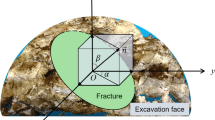Abstract
An enriched K-means clustering method for grouping fractures with meliorated initial cluster centers is proposed. Selection of the initial cluster centers is based on a gathering degree function and a hierarchical clustering method. A simplified Xie-Beni cluster validity index is applied to determine the optimal number of clusters automatically. The effectiveness of the proposed clustering method is demonstrated by using synthetic data and field data compiled from literatures. The gathering degree concept used in the density-based method is helpful in seeking suitable initial cluster centers. It alleviates the influence from the selected arbitrary threshold to get a more stable clustering result. The procedure to automatically remove fractures belonging to the obtained cluster center with the hierarchical clustering method is more natural than using the pre-defined radius. Additional advantage of the algorithm is that its convergence is fast, and it can be easily implemented for geological mapping result analysis.

















Similar content being viewed by others
References
Behzad T, Memarian H, Moshiri B, Rasouli V, Noubari HA (2011) Investigating the validity of conventional joint set clustering methods. Eng Geol 118:75–81
Cai MF, Wang P, Zhao K, Zhang D (2005) Fuzzy C-means cluster analysis based on genetic algorithm for automatic identification of joint sets. Chin J Rock Mech Eng 24:371–376 (In Chinese)
Fan L, Wang LQ, Tang HM (2007) Dynamic cluster analysis of discontinuity orientations of jointed rock mass. Rock Soil Mech 28:2405–2408 (In Chinese)
Hammah RE, Curran JH (1998) Fuzzy cluster algorithm for the automatic identification of joint sets. Int J Rock Mech Min Sci 35:889–905
Hammah RE, Curran JH (1999) On distance measures for the fuzzy K-means algorithm for joint data. Rock Mech Rock Eng 32:1–27
Hammah RE, Curran JH (2000) Validity measures for the fuzzy cluster analysis of orientations. IEEE T Pattern Anal 22:1467–1472
Huh M-H (2002) Setting the number of clusters in K-means clustering. In: Baba Y, Hayter A, Kanefuji K, Kuriki S (eds) Recent advances in statistical research and data analysis. Springer, Japan, pp 115–124
Jia HB, Tang HM, Liu YR, Ma SZ (2008) Theory and engineering application of 3-d network modeling of discontinuities in rockmass. Science Publishing house, Beijing, In Chinese
Jimenez R (2008) Fuzzy spectral clustering for identification of rock discontinuity sets. Rock Mech Rock Eng 41:929–939
Jimenez-Rodriguez R, Sitar N (2006) A spectral method for clustering of rock discontinuity sets. Int J Rock Mech Min Sci 43:1052–1061
Johnson S (1967) Hierarchical clustering schemes. Psychometrika 32:241–254
Klose CD, Seo S, Obermayer K (2005) A new clustering approach for partitioning directional data. Int J Rock Mech Min Sci 42:315–321
Lisle RJ, Leyshon PR (2004) Stereographic projection techniques for geologists and civil engineers. Cambridge University Press.
MacQueen, J., 1967. Some methods for classification and analysis of multivariate observations, Proceedings of the fifth Berkeley symposium on mathematical statistics and probability. California, USA, p. 14.
Moomivand H (2013) Effects of orientation, frequency, and number of sets of discontinuities on rock strength under triaxial stresses. Arab J Geosci 1–8
Pecher A (1989) SCHMIDTMAC—a program to display and analyze directional data. Comput Geosci-UK 15:1315–1326
Priest SD (1993) Discontinuity analysis for rock engineering, 1st ed, 1st edn. Chapman&Hall, London, New York
Scesi L, Gattinoni P (2009) Water circulation in rocks. Springer.
Shanley RJ, Mahtab MA (1976) Delineation and analysis of clusters in orientation data. J Int Assoc Math Geol 8:9–23
Terzaghi RD (1965) Sources of error in joint surveys. Geotechnique 4
Theodoridis S, Koutroumbas K (2008) Pattern recognition. Elsevier Science.
Verma A, Singh TN (2010) Modeling of a jointed rock mass under triaxial conditions. Arab J Geosci 3:91–103
Wang JH (1999) A new statistical grouping method of orientation data of fractures. Express Water Res Hydropower Inform (EWRHI) 20:27–28 (In Chinese)
Wong LNY, Liu G (2010) An improved K-means clustering method for the automatic grouping of discontinuity sets, 44th US Rock Mechanics Symposium and 5th US-Canada Rock Mechanics Symposium.
Xie X l, Beni G (1991) A validity measure for fuzzy clustering. IEEE T Pattern Anal 13:841–847
Xie JW, Zhang YB, Jiang WG (2008) A K-means clustering algorithm with meliorated initial centers and its application to partition of diet structures, International Symposium on Intelligent Information Technology Application Workshops, 2008. IITAW '08., pp. 98–102.
Xu ZH (2013) Topological pipe network method for underground water flow simulation and engineering applications. School of Civil Engineering, Shandong University, China
Zhang YJ, Cheng EX (2013) An optimized method for selection of the initial centers of K-means clustering. In: Qin Z, Huynh V-N (eds) Integrated Uncertainty in Knowledge Modelling and Decision Making. Springer, Berlin Heidelberg, pp 149–156
Zhou W, Maerz NH (2002) Implementation of multivariate clustering methods for characterizing discontinuities data from scanlines and oriented boreholes. Comput Geosci-UK 28:827–839
Zhou YX, Zhou ZF, Sun QG (2005) Synthetical fuzzy clustering analysis for joints occurrence of rock mass. Chinese J Rock Mech Eng 24:2283–2287 (In Chinese)
Acknowledgments
The authors gratefully acknowledge the support from the National Basic Research Program of China (973 Program, Grant No. 2013CB036000), the Fundamental Research Funds of Shandong University (Grant No. 2014GN028) and the State Key Laboratory for GeoMechanics and Deep Underground Engineering, China University of Mining & Technology (Grant No. SKLGDUEK1309).
Author information
Authors and Affiliations
Corresponding author
Rights and permissions
About this article
Cite this article
Ma, G.W., Xu, Z.H., Zhang, W. et al. An enriched K-means clustering method for grouping fractures with meliorated initial centers. Arab J Geosci 8, 1881–1893 (2015). https://doi.org/10.1007/s12517-014-1379-x
Received:
Accepted:
Published:
Issue Date:
DOI: https://doi.org/10.1007/s12517-014-1379-x




